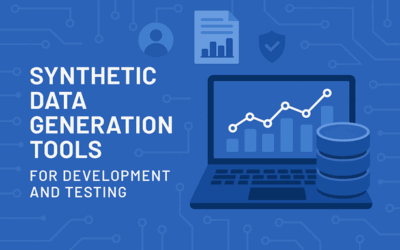Test Environment Anti-Patterns
by Niall Crawford
An Anti-Pattern is basically a commonly occurring approach to a problem or task that generates decidedly negative consequences.
(1) spaghetti code i.e. code that becomes unmaintainable and difficult to extend
or
(2) duplicate code i.e. code that has been cut and paste and now must be changed in two places.
However, what people often forget is that probably over 80% of SDLC activity involves more than just coding and is made up of a complex fabric of different teams, processes, infrastructure, data & tools. All of which can have a hugely detrimental effect on quality, timeliness and IT spend.

With the above in mind, enov8 decided to list eight of the top anti-patterns & patterns in the world of Test Environment Management. Anti-Patterns) which cause disruption, inhibit testing productivity & cause IT Project delays.
The Top 8 Anti-Patterns of Test Environments Management
1 Death by Spreadsheet
Anti-Pattern: The organisation is heavily reliant on spreadsheets to identify current systems under management, their components, versions and the projects using them. These spreadsheets often get out of date, are non-integrated across teams & regularly become unusable.
Pattern: A centralised CMDB or Knowledge Portal that all teams can use for visualisation, modelling and ongoing-management of systems, components, relationships, versions, and of course relationships.
2 System Contention Hell
Anti-Pattern: Different teams “reactively” compete for the same system resources and components, causing test disruption & outages due to continual changes and re-configurations. Collaboration across projects is typically low and often results in finger pointing and arguments.
Pattern: Project requirements are identified early in the lifecycle and the correct system resources are shared with the most compatible teams. In areas of high contention, the organisation has time to provision new environments and/or re-prioritise to meet the spike in demand.
3 Ninja Changes
Anti-Pattern: Developers deploy changes during operational hours, without prior notice and re-configure applications on the fly. The test teams are blind-sided, experience unusual disruption and defects arise that are difficult to recreate or track.
Pattern: All environment activity is collaborated through group calendars that highlight scheduled events and statuses. Affected teams are notified of changes, via alerts or dashboarding, that may impact their project or team.
4 The Email Support Vortex
Anti-Pattern: Members across the project use email as a method to request test environment support and coordinate operational fulfilment. High volumes of emails go across different teams and fail to convey ownership, accountability or correct operational procedures. Thus, requests become overwhelming, uncoordinated and are often ignored & orphaned.
Pattern: All environments, whether production or test, need a basic level of service management to prevent operational chaos. Although not necessarily as “heavy” as production, the organisation needs “just enough” service management to ensure all requirements are captured, tracked & closed.
5 Superhero Provisioning
Anti-Pattern: Deployment (data, application & infrastructure) operations are unrepeatable, manual, slow and error prone. They typically involve heroics from one or more subject matter experts and the use of “black magic”. This chaotic approach consequently results in disruption to the end users i.e. project and test teams.
Pattern: Organisations need to establish consistent tasks that are clearly documented and understood. Ideally these operations should evolve to become fully automated, “Single command line” tasks that can be exposed through “Self Service” forms.
6 Manual Health Checks
Anti-Pattern: Every morning the test team will get in early to run various functional tests that ensure the application and the end-to-end business processes are working. Results are then emailed to the test teams. Process is typically time-consuming and typically can only be done once a day.
Pattern: Implementation of Test Synthetics that can automatically run at any time of the day, (scheduled or in real time) to provide immediate insight into whether the end-to-end environments are healthy. Results can be communicated via real-time dashboards and automated alerts.
7 Stopping the Clock
Anti-Patterns: Testing and projects are often delayed due to the various engineering/provisioning teams not being available to service them. For example, the infrastructure team are too busy to provide more virtual test environments, the deployment team are too busy to release the latest code version and the data team don’t have time to provide more test data.
Pattern: Establishment of Self Service orchestration gateways (portals where provisioning automation is exposed & shared) will ultimately mean much of the “busy” work previously done by the Infrastructure, Application or Data team can be completed by the testers or project team themselves.
8 Creative Reporting
Anti-Pattern: The test environment & release management teams spend many days (potentially weeks) per month collating and analysing non-integrated environment & release information with the intent of creating reports. Typically resulting in reports which are invariably inaccurate & untimely.
Pattern: Establish automated environment information aggregation that brings together all your IT environment & release information and generates real-time reports and dashboards that support analytics and decision making.
If you’d like to know how to avoid anti-patterns and address all the above and more, then please ask for a demonstration of enov8 Environment Manager. A complete solution for your Test Environment Managers, including features for: Visual Configuration Management, Project Demand Management & Test Environment Bookings, Environment Calendaring, Service Management, Self Service, Test Synthetics, Environment Dashboarding and Automation Integration & Orchestration.
Relevant Articles
7 Synthetic Data Generation Tools for Dev & Testing
In software development and testing, having access to high-quality, realistic data is crucial. But real production data is often sensitive, regulated, or simply unavailable for testing purposes. Synthetic data generation tools provide a powerful alternative, enabling...
The SAFe Hierarchy and Levels, Explained in Depth
The Scaled Agile Framework (SAFe) is a comprehensive set of principles and practices designed to help organizations adopt agile methods on an enterprise level. It provides a set of guidelines and best practices that enable large-scale product development with agility....
DORA Compliance – Why Data Resilience is the New Digital Battlefield
How Enov8 Helps Financial Institutions Align with the EU's Digital Operational Resilience Act Executive Introduction As of January 2025, the EU's Digital Operational Resilience Act (DORA) has become legally binding for financial institutions operating across the...
Data Fabric vs Data Mesh: Understanding the Differences
When evaluating modern data architecture strategies, two terms often come up: data fabric and data mesh. Both promise to help enterprises manage complex data environments more effectively, but they approach the problem in fundamentally different ways. So what’s...
What Is Release Management in ITIL? Guide and Best Practices
Managing enterprise software production at scale is no easy task. This is especially true in today’s complex and distributed environment where teams are spread out across multiple geographical areas. To maintain control over so many moving parts, IT leaders need to...
Test Environment: What It Is and Why You Need It
Software development is a complex process that requires meticulous attention to detail to ensure that the final product is reliable and of high quality. One of the most critical aspects of this process is testing, and having a dedicated test environment is essential...










